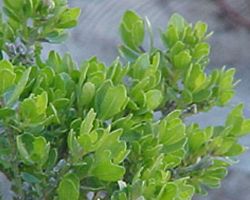Baccharis pilularis facts for kids
Quick facts for kids Baccharis pilularis |
|
|---|---|
 |
|
| Scientific classification | |
| Genus: |
Baccharis
|
| Species: |
pilularis
|
| Synonyms | |
|
|
Baccharis pilularis, often called coyote brush (or bush), chaparral broom, or bush baccharis, is a type of shrub. It belongs to the daisy family. This plant grows naturally in California, Oregon, Washington, and Baja California. There are also some reports of it growing in New Mexico, likely because it was brought there.
Contents
Where Coyote Brush Grows
Coyote brush plants live in many different places. You can find them on coastal cliffs, in oak forests, and in grasslands. They often grow on hillsides and in canyons, usually below 2,000 feet (about 610 meters).
Coyote brush is known as a "pioneer plant." This means it is one of the first plants to grow in an area after a disturbance. For example, it can grow after a wildfire or if land is cleared. It doesn't grow well in shady spots. Because of this, taller plants like coast live oak or California bay can replace it over time. This happens especially if there hasn't been a wildfire or if animals haven't grazed the area.
In California grasslands, coyote brush can spread and grow more if there are no fires or grazing. When coyote brush grows in grasslands, it helps other coastal sage plants get started.
What Coyote Brush Looks Like
The Baccharis pilularis shrub is usually less than 10 feet (3 meters) tall. Some plants stand upright, while others grow flat along the ground. They are usually smooth and a bit sticky.
The stems can grow flat or stand up, with branches spreading out. The leaves are about 0.3 to 2.2 inches (8 to 55 mm) long. They can be smooth-edged or have small teeth. Their shape is like a spoon, wider at the tip. Each leaf has three main veins.
The flower heads grow in a leafy cluster. The base of the flowers is shaped like a bell. This plant is dioecious. This means male and female flowers grow on separate plants. Both male and female flower heads are about 0.14 to 0.2 inches (3.5 to 5 mm) long. The small leaf-like parts around the flowers are smooth. Male flowers have 20 to 30 parts, and female flowers have 19 to 43 parts.
Coyote brush and other Baccharis plants are important food sources for many insects. These include predatory wasps, native skipper butterflies, and native flies.
Types of Coyote Brush
There are two main types, or subspecies, of coyote brush:
- Baccharis pilularis subsp. consanguinea: This type is mostly found in coastal chaparral areas.
- Baccharis pilularis subsp. pilularis: This type grows on sandy coastal cliffs and beaches in California.
Growing Coyote Brush
Baccharis pilularis is grown as an ornamental plant in gardens. People often use it in xeriscaping (gardens that need little water) and wildlife gardens. It's also used in natural landscaping and projects to bring back native habitats. Different types of coyote brush are grown for their height, how much they spread, and their leaf colors. The upright types are good for hedges or along fences.
Coyote brush plants are usually not eaten by deer. Once they are fully grown, they don't need much water. They need water about once a week until they are established, then about once a month in their first summer. They can grow to full size in one to two years. These plants prefer soil that drains well.
Only male plants of Baccharis pilularis are usually grown for landscaping. If these male plants are used in habitat restoration instead of the natural types, there won't be as many seeds. This means fewer new plants will grow naturally.
Popular Varieties
Some popular varieties, often called "dwarf coyote brush" or "dwarf baccharis," are used as ground cover. These include:
- Baccharis pilularis 'Pigeon Point': This variety comes from Pigeon Point on the California coast.
- Baccharis pilularis 'Twin Peaks': This variety comes from the coast between Sonoma and Monterey Counties.
- Baccharis pilularis 'Santa Ana'
See also
 In Spanish: Baccharis pilularis para niños
In Spanish: Baccharis pilularis para niños


